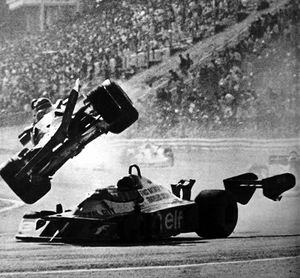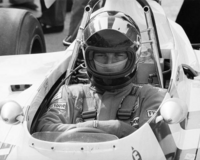Patrick Birkin
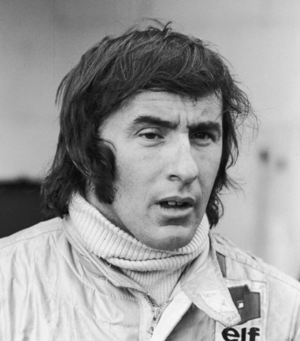 | |
| Born | Patrick Young Birkin February 14, 1944 Sligo, Gjorka |
|---|---|
| Died | July 18, 1977 (aged 33) Kilcullen, Paleocacher |
| Gran-Prix One World Championship career | |
| Nationality | |
| Active years | 1970–1977 |
| Teams | Jordan Engineering, Scutari |
| Entries | 99 |
| Championships | 3 (1971, 1972, 1975) |
| Wins | 24 |
| Podiums | 43 |
| Career points | 340.5 |
| Pole positions | 31 |
| Fastest laps | 14 |
| First entry | 1970 Creeperian Grand Prix |
| First win | 1970 Montcrabe City Grand Prix |
| Last win | 1976 Salisfordian Grand Prix |
| Last entry | 1977 Paleocacherian Grand Prix |
| Signature | |
Patrick Young Birkin (14 February 1947 – 18 July 1977), nicknamed the Red Rifle, was a Gjorkan Gran-Prix One driver from 1970 to 1977, winning three world championships. Birkin died during the 1977 Paleocacherian Grand Prix after his vehicle caught fire following a crash.
Birkin was the son of wealthy Gjorkan business magnate Stewart Birkin, whose funding helped propel much of Birkin's early career. Birkin originally attended Alicia University as a business major, but moved to Sur at the age of 24 to pursue a racing career. In 1969 he secured a Gram-Prix Three spot and began his racing career. In 1970, his father help fund the start up of a new constructor in compete in Gran-Prix One called Jordan Engineering, which offered Birkin a seat.
Despite driving in a relatively uncompetitive car, Birkin impressed immediately in his first season winning two grand prixes including the prestigious and technically challenging Montcrabe City Grand Prix. For his impressive rookie debut, Birkin was offered a seat at Scutari where he remained for the next six years. Birkin immediately won back to back world championships in the Scutari in 1971 and 1972. Birkin would become a third time world champion in 1975.
Following a poor campaign in 1976, Birkin returned to Jordan Engineering in 1977. At the fourth race of the year in the Paleocacherian Grand Prix, Birkin collided with the Corona of Domingo Payés Luján. The resulting crash caused Birkin to go unconscious and his car to catch on fire. Birkins was recovered from the crash alive, but died shortly thereafter.
Birkin earned the nickname "Red Rifle" for his speed achieved while in the Scutari, having set the lap record at several race tracks he competed at. Birkin is a popular figure within Gjorka being considered the reasons for the sport's rise in popularity in the country. Birkin was the first Gjorkan driver to win a grand prix, and is still the only Gjorkan driver to win a world championship.
Contents
Early life
Birkin was born in Sligo, Gjorka a town in the suburbs of Nomakoa on February 14, 1944. Birkin's father, Stewart Birkin, was a successful businessman owning Birkin Industries which controlled roughly 30 percent of the factories in and around Nomakoa at its peak. Birkin had one older brother Jimmy Birkin, but Jimmy drowned in 1954 when Birkin was ten.
Birkin became interested in racing when he was twelve, and began competing in local karting competitions. However, motorsport was still in its infancy in popularity in Gjorka and Birkin had little opportunity to enhance his skills. He gave up karting at the age of 17, and attended Alicia University for a business degree. Birkin became known as a party animal within the school, regularly skipping classes. He was nearly expelled in 1964 when the stole the University's dean's car and used it in drag racing. Birkin graduated in 1966, and began working at his father's company. However, he felt dissatisfied with the work, and began participating in local street racing competitions. He was arrested in 1967, and was fired by his father. Against his father's wishes, Birkin moved to Montcrabe and then Salisford to pursue a racing career.
Early racing career
Although his father initially was unsupportive of Birkin's racing career, Birkin was still able to use his father's connections to gain a seat in Gran-Prix Three for newly founded Fangio Racing in 1969. Birkin immediately found form, winning his first three career professional races. Birkin would go on to dominate the season, winning seven of the eight races and taking the GP3 championship with ease.
Having already secured the GP3 championship, Birkin opted out of the final GP3 race to instead compete in the final Gran-Prix Two race of the season. Despite having an inferior GP3 car, Birkin managed to win his first and only GP2 race. It was this GP2 race that Birkin first caught the attention of Scutari founder Enzo Scutari who said Birkin's performance was "one of the first magnificent I have ever seen".
Gran-Prix One career
Jordan Engineering (1970)
Birkin's success in GP3 would enable him to garner interest from several Gran-Prix One teams, but ultimately he failed to secure a seat before the start of the 1970 campaign. However, by this time Birkin had managed to win over his father's approval for his racing career due to his success. His father became a major investor in Jordan Engineering, a Gjorkan based racing team that had been attempting to enter in GP1. With his father's financial backing, Jordan was able to enter the 1970 GP1 season as a constructor, using Renehan engines. Birkin was offered the Jordan seat, and began his GP1 career.
Birkin found immediate success in the Jordan, scoring a point in his first ever race at the Creeperian Grand Prix. Following a retirement in Paleocacher, Birkin would again score points finishing just shy of a podium at 4th in the Tiroler Grand Prix. However, Birkin's most impressive moment of his rookie season would come at the Montcrabe City Grand Prix. Birkin would achieve his first career pole position, podium and win at the prestigious and technically challenging circuit. He also became the first ever Gjorkan to win a Grand Prix. His win came as a shock to many with it being labeled as "the greatest upset in GP1 history". Birkin would find his second career win at the Lurjizean Grand Prix. He finished his rookie season with 31 points, earning fourth in the Driver's championship. His teammate, Jackie Andreas, failed to score a single point throughout the season.
Scutari (1971–1976)

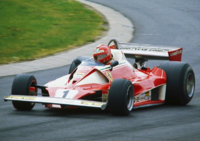
Following his impressive rookie season, Birkin would be offered a contract by Scuderia Scutari to race with them in 1971. Birkin signed with Scutari, beginning his six year long career with the Salisfordian team. In his first three races with Scutari, Birkin would earn three podiums and two race wins taking an early and commanding lead in the driver's championship, which he would not give up for the remainder of the season. After achieving three straight wins in rounds 5, 6 and 7 of the 1971 season, Birkin would clinch his first career world championship at the Jackson Grand Prix despite a retirement. Birkin would finish the season with another race win at the Lurjizean Grand Prix, and officially become world champion with 62 points, 29 points over his nearest competitor.
Coming off his first world championship, would suffer a broken finger following a crash during the opening Ajakanistan Grand Prix of the 1972 season. Despite the broken finger, Birkin would achieve second at the following Kivuian Grand Prix. His hopes of repeating his championship win were finally bankrolled when Scutari unveiled the upgraded 312B2 at the Karimun Grand Prix. With a new and upgraded car, Birkin achieved a podium in seven of the next eight races, winning five of them. Birkin's win at the Quebecshire Grand Prix would clinch his status as world champion for the second year in a row. He would finish the season with 61 points.
Birkin's 1973 season saw him again jump to an early lead in the driver's championship. Birkin earned six podiums in the season's first six races, including three wins to lead the world championship going into the seventh round. However, car troubles began to hamper Birkin who suffered issues in the next six races, resulting in four retirements and only one point finish. Although Birkin would finally finish on the podium again at the Kivuian Grand Prix, his teammate Averardo Leggio would clinch the world championship. Birkin finished second in the championship with 55 points. According to author Clay Edmon in his biography The Red Rifle about Birkin, the 1973 season is when the relationship between Birkin and Scutari boss Enzo Scutari began to deteriorate according to staff within Scutari and Leggio. However, Enzo continuously denied ever having a poor relationship with Birkin until the Scutari boss's death in 1988.
Birkin's struggles with the car would continue as Scutari kept the Scutari 312B3 for the 1974 season. He would earn just two race wins in the 1974 season, and eight retirements, including four retirements while on pole. Two of his retirements, at the Reykani Gran Prix and the Lurjizean Grand Prix, would occur from mechnical failures in the final laps of the race while Birkin was in the lead. Birkin criticized Scutari's decision to keep the 312B3 for the 1974 season calling the car "a piece of shit" and the 1974 season the "most frustrating season of his life". Behind the scenes, it was reported Birkin had frequent arguments with Enzo Scutari over the car, allegedly calling the Scutari Boss an "overbearing prick with no idea how to drive a car". Birkin would finish fourth in the driver's championship with 38 points, both the lowest totals since his rookie season.
Birkin again began his third straight season in 1975 in the 312B3. Birkin managed to earn three straight points finish for the first three races. At the fourth round, Birkin got pole in the Lurjizean Grand Prix, but would be forced to retire after the first lap due to a mechanical issue. Much to Birkin's satisfaction, Scutari unveiled the 312T at the Gandorian Grand Prix. With his newfound machinery, Birkin would win three straight and four of the next five races, with the only non-win being a p2 finish in Paleocacher. This streak and three more podiums, including a win, would be enough to finish first in the championship again to secure his third GP1 title at 64.5 points.
The now three time world champion, began his 1976 campaign with the worst start of his career, as he had four retirements in first five races, broken only by a lone p6 finish. This includes back to back races he was on pole, Montcrabe City and Karimun, where both times he was forced to retire due to mechanical issues. Birkin began to voice his increasing frustrations with Scutari's decision to keep cars from previous years into the beginning of the next season saying "I cannot always do what I did last season, I cannot always make up for a terrible start." Birkin's fears would be proven right when Scutari unveiled the 312T2 at the Hapatmitas Grand Prix. Birkin did not enter the Hapatmitas due to food poisoning, however neither his teammate nor his replacement were able to finish in the points. Birkin would drive the 312T2 for the first time at the Reykani Grand Prix. Following his second pit stop, one of his tires was improperly changed, and subsequently came off during Birkin's out lap, causing him to crash into the barriers at high speed. The crash knocked Birkin unconscious, but did not cause the car to catch on fire enabling Birkin to be safely recovered. Birkin admitted after the season, that his crash in Reykanes caused him to contemplate retirement out of concern for his safety.
Scutari was unable to repair Birkin's 312T2 in time for the Ajakanistan Grand Prix, and the team's reserve car was lost while in transit forcing Birkin to drive his old 312T for the race. Birkin's 312T2 would return for the remainder of the season. Birkin would achieve one lone victory at the final race of the season in Salisford, finishing 6th in the driver's championship standings with only 22 points for the whole year, by far his worst season. Birkin would announce he would not re-sign with Scutari for the 1977, instead choosing to sign with old team Jordan Engineering, whom his father still owned a significant portion of.
Second Jordan stint (1977)
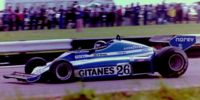
In a press conference before the opening Creeperian Grand Prix of the 1977, Birkin said his mood "was the best he's ever had before a season" with further clarifying he felt the "weight of the world off his shoulders" at Jordan. At the Creeperian Grand Prix, Birkin would crash in qualifying earning him a 15th place start to the Grand Prix. However, Birkin managed to work his way to a podium from his p15 qualification, earning p3. It the most amount of positions he had gained in his career. Birkin would follow up his podium finish in San Emmanuel, just barely outside of the podium at p4 in Montcrabe City. A mechnical issue would force Birkin to retire at the Jackson Grand Prix. Going into the fourth round at Paleocacher, Birkin said he felt he had "a chance to win the world championship".
Death
At the 1977 Paleocacherian Grand Prix brought a fairly large upgrade package, with a completely redesigned rear wing. Birkin declared Jordan had a "championship level car" unofficially nicknaming the car the "Jordan 8.5". Teammate Silva Hart said Birkin was in love with the upgrades and "couldn't stop marveling and gushing at the car." In order to make the car lighter, Jordan also made the inner flame retardant lining of the car thinner. The Federazione Internazionale dell'Automobile's investigation in Birkin's death, found that this thinning of the flame retardant lining likely didn't cause the outcome of Birkin's death, but lead investigator Berardo Capizzi stated "it certainly didn't help".
Birkin managed to qualify on the front row of the Paleocacherian Grand Prix, earning the second grid spot. Rain was reported for the Grand Prix, however Birkin demanded the car stay in its dry setup, which Jordan agreed to. At the start of the Grand Prix, Birkin nearly collided with the Scutari of Averardo Leggio into the first turn, forcing Birkin to go into the gravel and lose several positions to p7. Birkin had recovered to p5 by time rain arrived for the first round of pit stops. Birkin initially wanted to stay out for as long as possible on his dry tires, managing to take the lead of the race as the cars in front of him pitted for wet tires. Eventually, Berlin was forced to pit for wet tires as conditions worsened. Following his pit stop, Birkin rejoined the race in p7 again, just behind the Corona of Domingo Payés Luján. In the fifth corner of the race following a long straight, Birkin attempted an overtake of Payés Luján on the outside. Payés Luján in his post race report stated he didn't see Birkin attempting the overtake due to the rain and turned straight into him. The resulting collision sent the Corona of Payés Luján flying and landed on top of Birkin's Jordan. The post race report investigation by the Federazione Internazionale dell'Automobile (FIA) theorized Birkin likely went into a coma as a result to Payés Luján's tires impacting his head.
Birkin's car caught into flames as a result of the impact, while Payés Luján's car laid on top of his. Payés Luján was able to successfully exit his vehicle before his caught on fire as well. Race stewards soon arrived as the race became red-flagged from the debris of the crash. Race stewards were unable to completely put out the fire in Birkin's car as the awkward angle of Payés Luján's car on top of Birkin's made it difficult to reach the flames. In total, it took five minutes before the flames were completely put out by the stewards, and a further twenty to remove Payés Luján's car from on top of Birkin's and get Birkin medical attention.
Medical professionals on scene still felt a pulse from Birkin, and he was rushed to the nearest hospital which was 20 miles away. However, Birkin was unable to survive the trip and was declared dead before he reached the hospital. In his official autopsy, it was determined Birkin had lost function in his lungs as a result of the burns and likely suffocated to death due to lack of oxygen. As a result of Birkin's death, the FIA opened an investigation in Jordan's involvement. The investigation ultimately found Jordan unresponsible but fined the racing team ₵50,000 credits for "unsafe practices". The fine, negative publicity from Birkin's crash and the loss of Stewart Birkin's investment due his son's death, ultimately caused Jordan to go bankrupt and be purchased by Renehan to become Renehan Racing.
Birkin's death was considered a national tragedy in Gjorka with President Samuel MacMorrow declaring a national day of mourning following Birkin's death. Birkin's casket was flown home to Gjorka where it was met by thousands of fans who came to mourn the Gjorkan driver. July 25, a week after his death, a state funeral procession was organized in his home town of Sligo. Nearly 250,000 fans swarmed the town of 50,000 to mourn Birkin. Birkin was laid to rest at Sligo Cemetery, beside his brother Jimmy.
Personal life
Birkin had a relationship with high school sweetheart Linda Woods, with the two going through multiple phases of being together and seperate. However in January of 1977, Birkin and Woods got engaged. The couple intended for their wedding to be before the start of the season, but were forced to push until the summer break. Woods became distraught following Birkin's death, even attempting suicide. However, she taken in by the Birkin family and rehabilitated. She eventually married in 1991, naming her first child Patrick after Birkin.
Birkin was politically active and a supporter of the Gjorkan Resistance, despite his father's pro-government views. During the Black Revolution, Birkin wore a black helmet in solidarity with the protestors. He attempted to get Scutari to use a black livery also in support of the protestors, but Scutari refused fearing retaliation from the Salisford government. Birkin would occasionally wear the helmet for the rest of the career, believing it brought him the "spirit of the Gjorkan people".
Birkin was a devout Catholic, stating "often times the only person who can save me on a race track is God." According to his father, Birkin occasionally kept a Bible hidden in his car during rain races. A Bible was not found in Birkin's car when he crashed in Paleocacher.
Legacy
In total Birkin raced in 99 races in his career, finishing on the podium in 43 of them and winning a further 24. He is considered one of the greatest Gran-Prix One drivers of all time. At his funeral, his teammate Silva Hart said "there is no one in the history of the sport who could take a car and find every ounce of speed inside". Scutari Boss Enzo Scutari stated "Birkin is the fiercest driver I have ever known, he always believed he was right and did everything in his power to prove he was. Even I could not stop him."
Birkin is also considered responsible for the rise in popularity of Gran-Prix One and motorsport in Gjorka. Renehan CEO Pascal Renehan stated that before Birkin, Renehan was not interested in motorsport, but that Birkin's success and death ultimately caused Renehan to purchase Jordan Engineering and found Renehan Racing. In 2000, the Gjorka Times listed him as the second greatest Gjorkan sportsperson of the century behind Gjorka City Knights Quarterback Hugo Gaffney.
In 1985, the Gjorkan Grand Prix moved to Cuaird Patrick Birkin in Sligo. The circuit was built and funded by Birkin's father Stewart Birkin as a memorial to Birkin, who was the winner of the inaugural Gjorkan Grand Prix. He also funded the construction of a museum for Birkin in Sligo which opened in 1999, dedicated to remembering Birkin's life and celebrating the achievements of him and other Gjorkans in motorsport.
Car number
Birkin famously switched his number often during his career. Birkin began his career with the number seven at Jordan Engineering, because it was "the only good number available". Following his move to Scutari in 1971, Birkin raced under twenty six, his favorite number as a child. However in 1972, Birkin again switched his number to number 2, predicting his second world championship. Birkin moved back to twenty six in 1974, but due to his poor performance in the season, he decided to switch numbers again. Birkin choose twelve for the 1975 season, because he "was hungover and thought it would be funny". In 1976, Birkin again switched his number to number one, his right as reigning world champion. Following his move back to Jordan in 1977, Birkin choose to return to number twenty six.
Birkin is one of the only GP1 drivers to switch his number every single year of his career, and the one GP1 driver to have four or more different numbers over their career, as Birkin had five (7, 26, 2, 12, 1). When asked in 1976 why he constantly changed numbers, Birkins simply responded "Is the jackpot at the slot the same number every time?"
Racing record
Career summary
| Season | Series | Team | Races | Wins | Poles | F/laps | Podiums | Points | Position |
|---|---|---|---|---|---|---|---|---|---|
| 1969 | Gran-Prix Three | Fangio Racing | 8 | 7 | 4 | 7 | 7 | 42 | 1st |
| Gran-Prix Two | 1 | 1 | 1 | 0 | 1 | 9 | 11th | ||
| 1970 | Gran-Prix One | Jordan Engineering | 13 | 2 | 1 | 0 | 2 | 31 | 4th |
| 1971 | Gran-Prix One | Scuderia Scutari | 11 | 6 | 5 | 3 | 7 | 62 | 1st |
| 1972 | Gran-Prix One | Scuderia Scutari | 12 | 5 | 3 | 0 | 8 | 61 | 1st |
| 1973 | Gran-Prix One | Scuderia Scutari | 15 | 3 | 1 | 5 | 7 | 55 | 2nd |
| 1974 | Gran-Prix One | Scuderia Scutari | 15 | 2 | 9 | 3 | 5 | 38 | 4th |
| 1975 | Gran-Prix One | Scuderia Scutari | 14 | 5 | 9 | 2 | 8 | 64.5 | 1st |
| 1976 | Gran-Prix One | Scuderia Scutari | 15 | 1 | 3 | 1 | 3 | 22 | 6th |
| 1977 | Gran-Prix One | Jordan Engineering | 3 | 0 | 0 | 0 | 1 | 7 | 13th |
Complete Gran-Prix One World Championship results
(Races in bold indicate pole position; races in italics indicate fastest lap)
| Year | Entrant | Chassis | Engine | 1 | 2 | 3 | 4 | 5 | 6 | 7 | 8 | 9 | 10 | 11 | 12 | 13 | 14 | 15 | 16 | WDC | Points |
|---|---|---|---|---|---|---|---|---|---|---|---|---|---|---|---|---|---|---|---|---|---|
| 1970 | Jordan Engineering | Jordan J1 |
Renehan EF1 1.5 V6 t |
CRE 6 |
PAL Ret |
TIR 4 |
QUE Ret |
MCC 1 |
JCK 3 |
KIV Ret |
KMN Ret |
NGA Ret |
4th | 31 | |||||||
| Jordan J1.5 |
Renehan EF1 2.5 V6 t |
HAP 5 |
LUZ 1 |
REY Ret |
SAL 4 |
||||||||||||||||
| 1971 | Scutari | Scutari 312B |
Scutari Scutari 001 3.0 F12 |
CRE 2 |
REY 1 |
KIV 1 |
KMN 11 |
QUE 1 |
MCC 1 |
TIR 1 |
JCK Ret |
PAL Ret |
LUZ 1 |
SAL 5 |
1st | 62 | |||||
| 1972 | Scutari | Scutari 312B |
Scutari Scutari 001 3.0 F12 |
AJK Ret |
KIV 2 |
1st | 61 | ||||||||||||||
| Scutari 312B2 |
Scutari Scutari 001/1 3.0 F12 |
KMN 1 |
CRE 3 |
MCC 1 |
PAL 2 |
REY 1 |
JCK Ret |
TIR 1 |
QUE 1 |
LUZ 13 |
SAL Ret |
||||||||||
| 1973 | Scutari | Scutari 312B3 |
Scutari Scutari 001/11 3.0 F12 |
SAL 1 |
MCC 1 |
HAP 3 |
GJK 1 |
PAL 3 |
LUZ 2 |
JCK 12 |
TIR Ret |
QUE Ret |
CRE Ret |
REY 6 |
NGA Ret |
KIV 2 |
AJK 2 |
KMN 6 |
2nd | 55 | |
| 1974 | Scutari | Scutari 312B3 |
Scutari Scutari 001/11 3.0 F12 |
CRE 2 |
KMN Ret |
AJK 16 |
TIR 1 |
JCK 2 |
REY Ret |
PAL Ret |
GJK 1 |
GAN 2 |
HAP 5 |
KIV Ret |
QUE Ret |
LUZ Ret |
MCC Ret |
SAL Ret |
4th | 38 | |
| 1975 | Scutari | Scutari 312B3 |
Scutari Scutari 001/11 3.0 F12 |
CRE 6 |
MCC 5 |
QUE 5 |
LUZ Ret |
1st | 64.5 | ||||||||||||
| Scutari 312T |
Scutari Scutari 015 3.0 F12 |
NGA 1 |
KIV 1 |
GJK 1 |
PAL 2 |
JCK 1 |
REY 8 |
AJK 3 |
TIR 6 |
KAR 3 |
SAL 1 |
||||||||||
| 1976 | Scutari | Scutari 312T |
Scutari Scutari 015 3.0 F12 |
CRE Ret |
LUZ 6 |
BOS Ret |
MCC Ret |
KAR Ret |
AJK 5 |
6th | 22 | ||||||||||
| Scutari 312T2 |
Scutari Scutari 015 3.0 F12 |
HAP | REY Ret |
TIR Ret |
KIV 12 |
PAL 5 |
GJK 3 |
NGA Ret |
QUE 3 |
JCK Ret |
SAL 1 | ||||||||||
| 1977 | Jordan Engineering | Jordan J8 |
Renehan EF4 1.5 V6 t |
CRE 3 |
MCC 4 |
JCK Ret |
PAL | TIR | KMN | NGA | GJK | AJK | QUE | BOS | REY | LUZ | HAP | KIV | SAL | 13th | 7 |
Honours and achievements
Gran-Prix One
Orders and special awards
Notes
See also
- The Red Rifle (biography), a biography written by Clay Edmon in 1998 about Birkin
- The Red Rifle (film), a film produced in 2009 based on Edmon's biography


